docent - A trained volunteer who provides educational tours for museum visitors.
A contemporary docent:
![]()
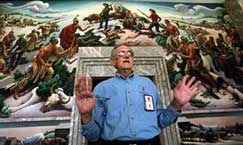
![]()
A docent leads a discussion about the mural
behind him.
Also see preparator and teacher.
documentary art - Any artwork the purpose of which is to present facts objectively, without inserting fictional matter, recording and/or commenting on some content, often political or social, by accumulating factual detail. Many conceptual art installations of the 1970s were overtly documentary — e.g., Post-Partum Project by Mary Kelly (American), the various Reading Rooms by Joseph Kosuth (American, 1945-), Guggenheim Trustees by Hans Haacke (German, 1936-). More common examples: documentary films. Not to be confused with documentation.
Example:
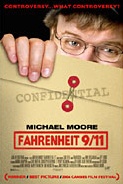

Michael Moore (American, contemporary), director and narrator, Fahrenheit 9/11, 2004, 35 mm film, c. 110 minutes. Moore's Web site calls it a "searing examination of the Bush administration's actions in the wake of the tragic events of 9/11." This and others of Moore's movies are typically called documentary films. But makers of documentary works are generally expected to be as objective as possible, and Moore is unappologetic about shaping (by his choice of interviewees, questions to them, narrative, and editing) his works (by his choice of interviewees, questions to them, narrative, and editing) in supporting his opinions. His films might be called editorialized, polemics, or diatribes, but they have also been called this P word — propaganda. At least in part, this is because others promote Moore's films to pursuade audiences to take Moore's opinions. Considering the negative connotations attached to the word "propaganda," people who enjoy such works would naturally prefer to categorize Moore's films as documentary rather than propaganda, wishing to give these films the most positive spin possible. Nevertheless, if Fahrenheit 9/11 merits the use of the P word, Michael Moore is apparently rehabilitating it.
documentation - Textual and/or photographic information that describes a work of art or image, recording its physical characteristics and placing it in context, as in records of works of conceptual art, earth art, or performance art.
Example:

Richard Long (English, 1945-), A Hundred Mile Walk, 1971-2, pencil,
map, printed text, photographs and labels on board, 21.6
x 48.3 cm, Tate Gallery, London. All
of Long's work results from solitary walks he has undertaken
in different parts of the world. This work documents
the circular route he took on a walk
made in December and January of 1971-2, by means of a map showing
his location, a photograph of part of the landscape passed through
and phrases recording his thoughts and reactions. See earth art and line.

dodecagon - A closed shape bounded by twelve straight-line segments. The formula with which to find an equilateral dodecagon's area is 11.1961 times the length of one side squared.
Also see circle, dodecahedron, mathematics, polygon, radial, shape, and vertex.
dodecahedron - A polyhedron with twelve pentagonal faces. The regular dodecahedron is one of the five Platonic solids (along with the tetrahedron, hexahedron (cube), octahedron, and icosahedron. The faces of a regular dodecahedron are all regular pentagons.
(pr. DOH-də-kə-HEE-drən)
The plural form can be either dodecahedrons or dodecahedra.
Also see mathematics, polygon, and vertex.
![]()

![]()
dolly - A low platform on wheels used to move sculpture or heavy materials.
dolmen - Large stones
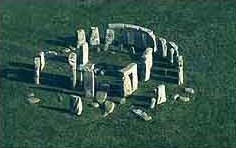 (megaliths)
standing upright with a horizontal
stone balanced upon them (post
and lintel). Numerous such structures have survived from Stone Age France and England — for
example, at
(megaliths)
standing upright with a horizontal
stone balanced upon them (post
and lintel). Numerous such structures have survived from Stone Age France and England — for
example, at Stonehenge,
c. 2,500-1,500 BCE,
stone, 162 inches high, and located 330 feet above sea level on
the chalk downland of Salisbury Plain, about 80 miles west of
London near the town of Amesbury. About half of the original monument
is missing, but enough remains to provide an idea of what it was
once like. It was built in three phases. The first phase saw the
digging of the "henge" that encloses the main area in
about 2800 BCE,
and the first arrangement of stones erected c. 2100 BCE.
Once on site, a "sarsen stone" was prepared to accommodate
stone lintels along its top surface. It was then dragged until
the end was over the opening of the hole. Great levers were inserted
under the stone and it was raised until gravity made it slide
into the hole. At this point,
 the stone stood on about a 30° angle
from the ground. Ropes were attached to the top and teams of men
pulled from the other side to raise it into the full upright position.
It was secured by filling the hole at its base with small, round
packing stones. At this point, the lintels were lowered into place
and secured vertically by mortice and tenon joints and horizontally
by tongue and groove joints. It was begun by people of the late
Neolithic period and completed by a Celtic people called Beaker
Folk for their use of pottery drinking vessels, began to use metal
implements and to live in a more communal fashion than their ancestors.
The popular story has been that Stonehenge was built by the Druids,
but they were Celts present during the much later time of Roman
occupation.
the stone stood on about a 30° angle
from the ground. Ropes were attached to the top and teams of men
pulled from the other side to raise it into the full upright position.
It was secured by filling the hole at its base with small, round
packing stones. At this point, the lintels were lowered into place
and secured vertically by mortice and tenon joints and horizontally
by tongue and groove joints. It was begun by people of the late
Neolithic period and completed by a Celtic people called Beaker
Folk for their use of pottery drinking vessels, began to use metal
implements and to live in a more communal fashion than their ancestors.
The popular story has been that Stonehenge was built by the Druids,
but they were Celts present during the much later time of Roman
occupation.
Other examples of dolmen:
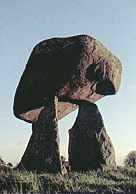
Celtic Ireland, Ravensdale, Cooley Peninsula,
County Louth, The Proleek Dolmen. Three upright stones
and a 46 ton capstone mark a 5000 year-old tomb. According to
local folklore, the capstone was placed by a giant.
![]()
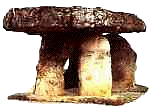
![]()
This is one of more than 4,000 Celtic dolmen
found in France — mostly in Brittanny and in southwestern France.
Other resources on dolmen:
Also see cairn, cromlech, Cyclopean, monolith, Seven Wonders of the Ancient World, and Stone Age.
dome - In architecture, a hemispherical [like half a ball] vault or ceiling over a circular opening. Theoretically, it is an arch rotated on its vertical axis. It rises above the central part of a building. Usually it is elevated further by being placed on a circular or many-sided base.
Here are example domes:

Coffered Dome of the Pantheon, Rome,
c. 118-128, interior view.
Another view of the interior. See coffer, oculus, and pantheon.

Filippo Brunelleschi (architect, Italian,
1377-1446), Dome of the Cathedral of Florence — "Il Duomo."
Its construction began in 1420. Brunelleschi was the first great
Italian Renaissance architect.
Octagonal and ribbed,
it's one of the finest domical constructions in architectural
history. Another view of this dome. See lantern.
Donato Bramante (Italian, 1444-1514), Tempietto of San Pietro, Montorio, Rome, Italy, after 1502, bearing masonry.
Andrea Palladio (Italian, 1508-1580), Villa Rotonda (Villa Capra), begun 1567, general view of exterior, Vicenza, Italy.

Mughal Emperor Shah Jahan (Indian, reigned
1627-1658), Taj Mahal, 1630-1653, an Islamic tomb
in a walled garden built for Shah Jahan's wife Mumatz Mahal [aka
Arjuman Banu Begum], of bearing masonry and inlaid
marble, with
onion-shape domes and flanking towers,
in Agra, India, seat of the Mughal
Empire. The mausoleum is 57 m (190 ft) square in plan.
The central inner dome is 24.5 m (81 feet) high
and 17.7 m (58 feet) in diameter,
but is surmounted by an outer shell nearly 61 m (200 feet) in
height. Sir Banister Fletcher
wrote in A History of Architecture, "The interior
of the building is dimly lit through pierced marble lattices
and contains a virtuoso display of carved marble. Externally
the building gains an ethereal quality
from its marble facings, which respond with extraordinary subtlety
to changing light and weather."
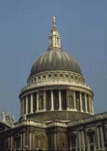
Christopher Wren (English, 1632-1723), St. Paul's Cathedral, London, looking
up at the dome from the southeast, 1675-1710.
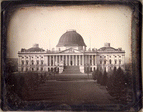
John Plumbe, Jr. (American, 1809-1857) photographer,
United States Capitol, Washington, D.C.,
east front elevation, half
plate daguerreotype,
c. 1846, Library of Congress, Washington, DC. One of the earliest
surviving photographs
of the Capitol, Plumbe's elevation shows the building with its
old copper-sheathed wooden dome.

R. Buckminster Fuller (American, 1895-1983)
architect, Geodesic Dome, 1967, on the site of the 1967
World's Fair, during which it housed the United States Pavilion.
Location: l'Ile-Ste-Hélène, Montreal, Canada. About
300,000 such structures of
various sizes are now scattered throughout the world, most such
polyhedrons were built in
the 1960s when interest in them was at its peak.

Andy Goldsworthy (English, 1956-), Stone Houses, 2004, two monumental
domes constructed of wood
(split rails from New England agricultural sources) and stone
(from Scotland), each 18 feet in height
and 24 feet in diameter,
Metropolitan Museum, NY. This installation
is in the museum's Roof Garden, an outdoor space for sculpture
with a great view of the city. The museum says the work was "inspired by Central Park and
its architectural
backdrop. Inherent in these seemingly simple forms
are the implicit power, beauty,
mystery, and elemental aspects
of nature, marked
by the passage of time
and by human contact." See earth
art and sculpture garden.
Also see boss, coffer, convex, di sotto in sù, finial, fish-eye lens, oculus, pendentive, and tower.
dominant - The part of a composition that is emphasized, has the greatest visual weight, the most important, powerful, or has the most influence. A certain color can be dominant, and so can an object, line, shape, or texture.
Also see contrast and focal point.
donation and donor - A donation is a voluntary transfer of an object from an individual or a business — a donor — to an institution. Every museum seeks donations. Because U.S. government funding for the arts has been under siege lately, many nonprofit institutions have become more reliant upon the financial support of individual and corporate donors.
Also see bad-debt art, collection, deaccession, motivation, patron, posterity, and registrar.
Doric - The earliest of the orders of classical architecture.
Examples:
A diagram of the Doric order and a diagram of the Ionic order.
![]()

![]()
Ictinus and Callicrates with Phidias (Greek),
The Parthenon, 477-438 BCE,
a temple dedicated to the goddess Athena, of bearing masonry,
cut stone, in a style
called the Doric order, on the historic acropolis
of Athens.
Related site:
Also see abacus, architrave, capital, classical orders, column, Corinthian, cornice, echinus, entablature, frieze, Greek art, Ionic, metope, Roman art, shaft, stylobate, and triglyph.
 dot - May refer to the most fundamental mark, one level more fundamental
than a line. And it may refer
to a particular point, or
location. Something having many dots has been said to be "punctuated."
When an area is occupied by dots, spots or speckles of many colors, it may be
described as variegated.
Also, "dot" is a computer term for either a pixel
or that punctuation also called a period or point.
dot - May refer to the most fundamental mark, one level more fundamental
than a line. And it may refer
to a particular point, or
location. Something having many dots has been said to be "punctuated."
When an area is occupied by dots, spots or speckles of many colors, it may be
described as variegated.
Also, "dot" is a computer term for either a pixel
or that punctuation also called a period or point.
Examples:
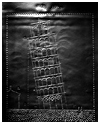
Abelardo Morell (American, born Cuba, 1948-), Leaning Tower of Pisa Illustration for the Blind, 2000, Morell's photograph of a book illustration intended to be "seen" by a blind person. This picture and the Braille text that is part of it is comprised entirely of embossed dots. See campanile.

Jim Hodges (American, 1957-), Dot, 1999, wood and metal
panel, ceramic
sockets, light bulbs, 31 1/2 x 31 1/2 x 5 inches, Kemper Museum
of Contemporary Art, Kansas City, MO. See light.
Also see blot, DPI (dots per inch), glitter, halftone, moiré, pointillism, punch, and stipple.
dotaku - In Japanese tradition, a ceremonial bronze bell which was kept buried in hillside santuaries away from everyday village life, and brought out only for use in certain agricultural rituals. Dotaku and their molds have been found in the Kinai (Kyoto-Osaka) district and the coastal region of the Inland Sea. Dotaku are classified chronologically into four groups, according to the styles of their handles. Though originally made to suspend the bells, handles became less functional and more ornamental in later years.
Example:

Japanese, Dotaku, Yayoi
Period, 2nd-1st century BCE,
bronze bell,
height 42.7 cm, reportedly
excavated in Kagawa Prefecture,
Tokyo National Museum. Japanese authorities consider this a "National
Treasure."
Also see Japanese art.
![]()

![]()
double-exposure - In photography, a technique that combines images made at different moments in time.
double 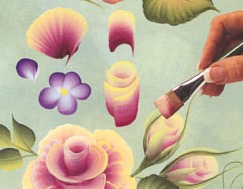 loading - Also called side
loading; loading a brush with two colors
side by side. This is a technique
typical of tole and other kinds
of decorative painting.
In order to double load, use a paint of creamy consistency,
and drag one edge of the brush
through the lighter color as many times as needed to fill that
edge with color; then stroke the clean edge of the brush through
the darker color in the same manner. Once the brush is loaded
this way, blend the colors at the center of the brush by stroking
on the palette. Using this technique,
each brushstroke (application
of color) deposits a gradation
of the two blended colors.
loading - Also called side
loading; loading a brush with two colors
side by side. This is a technique
typical of tole and other kinds
of decorative painting.
In order to double load, use a paint of creamy consistency,
and drag one edge of the brush
through the lighter color as many times as needed to fill that
edge with color; then stroke the clean edge of the brush through
the darker color in the same manner. Once the brush is loaded
this way, blend the colors at the center of the brush by stroking
on the palette. Using this technique,
each brushstroke (application
of color) deposits a gradation
of the two blended colors.
Related link:
Also see folk art.
![]()
![]()
![]() dovetailed - A means of joining
two pieces of wood or a thickness
of some other rigid material. The pieces are shaped in such a
way that they resemble doves whose rows of tails interlock.
dovetailed - A means of joining
two pieces of wood or a thickness
of some other rigid material. The pieces are shaped in such a
way that they resemble doves whose rows of tails interlock.
[Are doves' tails shaped like this?
Has anyone
actually seen doves put their tales together this way?
What a poetic word! -MD]

dowel or doweling - A length of round wood, either as it might naturally be formed or as it can be turned. Also, to insert such round lengths of wood as pegs into drilled holes in place of nails, bolts or screws to secure a joint between pieces of material. In ancient architecture, a wooden or metal pin placed between stones of different courses to prevent shifting.
Also see circle, clamp, cylinder, and masonry.
DPI or dpi - Dots per inch. A measurement of the scanning resolution of an image or the quality of an output device. Expresses the number of dots a printer can print per inch, or monitor can display, both horizontally and vertically. A 600-dpi printer can print 360,000 (600 x 600) dots on one square inch of paper.
Related link:
Also see aspect ratio, moiré, and monitor.
draftsman - An artist
who draws sketches
and plans  of buildings, machinery, and manufactured
products. Most contemporary drafting is done digitally,
using computers, but for generations, draftsmen drew upon
of buildings, machinery, and manufactured
products. Most contemporary drafting is done digitally,
using computers, but for generations, draftsmen drew upon drafting tables, using such analog
tools as rulers, T square,
triangles, compasses,
and French curves.

American, Become a Draftsman, Enjoy a Real Job in Industry,
advertisement for a correspondence
course, October 1937, Modern Mechanix magazine.
Also see architect and mechanical drawing.
draftsmanship - Skill in drawing.
Also see draftsman and pencil.
dragging - Applying relatively dry oil paints lightly over a surface, creating an area of broken color — the new color having attached to the high spots but not to the low, so that irregular portions of the undercolor remain exposed. Also known as scruffing.
Also see cissing, dry brush painting, and overpainting.
drama - See theater.
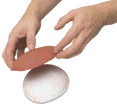
drape mold - 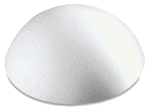
![]() Forms by which a piece (often a slab) of plastic material such as clay, wax, or glass can be shaped. Types of drape molds are hump, slump and press molds. The example shown to the right is a hemispheric hump mold made of plaster.
Forms by which a piece (often a slab) of plastic material such as clay, wax, or glass can be shaped. Types of drape molds are hump, slump and press molds. The example shown to the right is a hemispheric hump mold made of plaster. 
![]() The example to the left is a square plaster slump mold. A clay bowl, for instance, might be formed either by draping a slab of clay onto a hump mold or into a slump mold. In order to better separate the surface of the mold from that of the material shaped, you may need to employ a release agent. This might be a powder, an oil, or a sheet of tissue paper.
The example to the left is a square plaster slump mold. A clay bowl, for instance, might be formed either by draping a slab of clay onto a hump mold or into a slump mold. In order to better separate the surface of the mold from that of the material shaped, you may need to employ a release agent. This might be a powder, an oil, or a sheet of tissue paper.
drapery - Cloth or a representation of cloth arranged to hang in folds. This may be a curtain or a costume, or fabric used as a cover or as an object arranged as a passage in a composition. Just as the study of various means to representing the human figure is essential in the development of an artist's skills, so is the study of ways to represent drapery. Each is composed of curving surfaces reflecting gradations of colors. Each is essentially a set of loose folds of varying sizes, among which are occasional creases. Drapery varies amongst fabrics of different weights, textures, colors, and patterns, either hanging straight, disturbed by wind, or by parts of a body or an object in some relationship to it.
Examples of drapery in art:
Egypt, c. 1365-1349 BCE (reign of Amenhotep IV-Akhenaton, 18th dynasty), Body of Nefertiti (?), crystallised red sandstone, height 29 cm, Louvre. See Egyptian art and torso.

Gerard David (Netherlandish, born about 1455,
died 1523), The Rest on the Flight into Egypt, c.
1512-15, oil on wood
panel, 20 x 17 inches (50.8 x 43.2
cm), Metropolitan Museum of Art, NY. See chiaroscuro,
Madonna, Northern
Renaissance, and vignette.
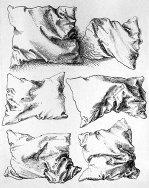
Albrecht Dürer (German, 1471-1528), Sechs Kissen (Six Pillows), 1493, ink on paper, 276 x 202 cm. Dürer produced this wonderful drawing when he was twenty-two years old. See hatching and cross-hatching and Northern Renaissance. There is Andreas Freise's (German, contemporary), 2001 95-line ascii version of this picture. (If you don't find it at that first link, try it here). Email Andreas Freise, Universitaet Hannover.

Albrecht Dürer,
The Walk, c. 1496-1498, 195 x 120 cm,
engraving, Hermitage
Museum, St. Petersburg, Russia. See costume.
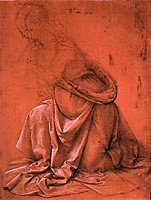
Leonardo da Vinci (Italian, 1452-1519), Study
of drapery of a woman kneeling to left, c. 1477, silverpoint on red surface
heightened with white, 25.8
x 19.5 cm, Corsini Gallery, Rome. See Renaissance and study.
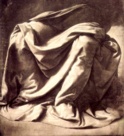
Leonardo da Vinci, Study for legs of seated figure, c. 1477,
brush on linen
heightened with white, 26.6
x 23.4 cm, Corsini Gallery, Rome.

Jan (or Johannes) Vermeer (Dutch, Delft,
1632-1675), The Glass of Wine, c. 1661/62, oil
on canvas, Gemäldegalerie,
Berlin. See Baroque
and Dutch art.

Etienne-Maurice Falconet (French, 1716-1791),
Winter, 1771, marble,
height 135 cm, Hermitage Museum,
St. Petersburg, Russia. See Neoclassicism
and Rococo.

John Singleton Copley (American, 1738-1815),
Drapery
Study for "The Portrait of Mary and Elizabeth Royall",
c. 1758, graphite and white
chalk on gray-brown
laid paper, approximate: 25.2
x 38.1 cm (9 7/8 x 15 inches), National Gallery of Art, Washington,
DC.

Jean-Auguste-Dominique Ingres (French, 1780-1867),
Princesse de Broglie, 1851-1853, oil on canvas,
47 3/4 x 35 3/4 inches (121.3 x 90.8 cm), Metropolitan Museum
of Art, NY. See Neoclassicism
and portrait.
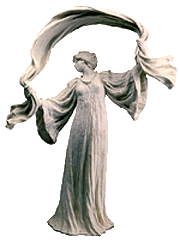
Agathon Léonard (French, 1841-1923)
for Sèvres, Royal Porcelain Factory, Dancing Figure from the Table Centrepiece 'Dance
with Scarves', 1900, bisque
porcelain, height 47.5 cm, Hermitage Museum,
St. Petersburg, Russia. This figure
is one of fourteen in a set of female figures dancing
and playing music. See Art Nouveau.
Henri Matisse (French, 1869-1954), The Yellow Curtain (Le Rideau jaune), c. 1915, oil on canvas, 57 1/2 x 38 1/8 inches (146 x 97 cm), Museum of Modern Art, NY.

Claudio Bravo (Chilean, 1936-), White Cloth, 1991, black conté
on paper, 34.9 x 27.9 cm, Ubicación
Colección Particular. See trompe l'oeil.
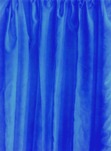
Claudio Bravo, Neptuno (Blue), 1998, lithograph,
image: 30.7 x 23 inches, sheet: 38.2 x 29.5 inches, published
by Marlborough Graphics, NY. This is one in a series of six lithographs,
called "Demi Gods": Venus (Black), Vesta
(Sanguine), Ceres (Sepia), Eros (Red), Neptuno
(Blue), and Flora (Green).

Lia Cook (American, 1942-), Drapery
Frieze: After Leonardo, 1992, linen,
rayon, and acrylic; dyed
and pressed, 65 x 240 inches (6 panels), collection of the artist.
See after and frieze.
Also see elegance, mannequin, and textile.

drawknife or drawtool - A metal blade with a wooden handle at both ends used to strip wood. Draw knives are made in various sizes and can be obtained with curved as well as the more common straight blades.
Also see spokeshave.
dress - To give the final texture to a hard medium, especially wood or stone, with chisels, hammers, points, etc.
Also see costume, drove, and tooth.
drill - A tool that bores a hole when revolved. In the most primitive examples it is revolved between the palms; then it was operated by means of a bow, and later also with a brace. The cutting is generally achieved by a metal point or bit, but in some cases the point of the drill is used with abrasives. There are many types of contemporary drills, including those that bore holes by both rotating abrasion and repeated blows. A drill press is a powered vertical drilling machine in which the point is pressed to the work by hand lever or automatically.
Also see twist drill and wood.
droit moral - This French term for "moral right" refers particularly to certain rights which all civilizations should recognize are held by those who create intellectual properties — artists (or their estates). These are artists' rights to:
Discussions about droit moral eventually turn to the extent to which moral rights should be tied to monetary rights, and the extent to which moral rights should be alienable. The concept of droit moral is the basis for all copyright laws. The Berne Convention is the premiere treaty governing international copyrights. Almost every major developed country has signed on to this treaty. An important variation from the Berne Convention: France's (and some other countrys') laws go farther than those of the US (and some other countries) in holding that each and every time a work is purchased, a share of monies paid should go to the artist.
(French pr. dwah moh-rahl)
Related resource:
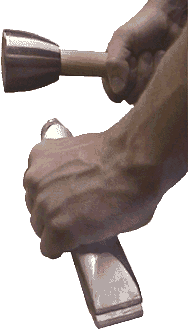
dromos - The passage to a beehive tomb.
drove - In carving stone, a flat chisel with a broad head generally used only for rough hewing. Also, a stone surface dressed with such a chisel.
Also see claw chisel and tools.
drum scanner - A high-quality image-capture device. The image to be captured is wrapped around a drum that spins very fast while a light source scans it to capture a digital version of the image.
Also see scanner.
![]()

![]()
dry brush - Applying relatively dry inks or waterpaints lightly over a surface, creating an area of broken color — the new color having attached to the high spots but not to the low, so that traces of the paper or undercolor remain exposed. This may be done by holding the brush so that the side of its bristles lie flat against the paper, or by pulling it rapidly across the surface. In oil painting, dragging stroke or scruffing is the name given to this effect. In Japanese art tradition, kasure are calligraphic dry brush strokes.
Also see gouache, marbling, scumble, tempera, and watercolor.
dry foot - The foot of a piece of ceramic work that has been cleared of glaze.
![]()
![]()
dry mount - A mounting technique in which film is applied in a pressing machine with heat in order to adhere one flat surface to another.
Also see photography and temperature.
dry transfer graphics - A  medium
primarily for graphic designers,
dry transfer graphics are manufactured graphic elements a designer
can transfer — remove — from a transparent backing sheet, and
reattach to a paper or other smooth
surface by pressing and rubbing
them, either wholly or in pieces — thus earning the nickname
"rub-downs." Dry transfer graphics offer a complete
system, providing a way to produce high quality
artwork in minutes. The kinds of dry transfer graphics available
include lettering, lines,
colors, shades,
textures, patterns, symbols,
and signs. These sheets can
be purchased from local art supply dealers, and online. Letraset, one of the major manufacturers of
dry transfer graphics, offers them online. Letraset currently
offers about twenty stock typefaces
and a custom service for three-dimensional
work, mockups, etc., along with drawing and charting tapes, adhesive
backed vinyl lettering, and other products. This technology was
much more commonly used in the twenty years before the arrival
of computer graphics, but these
design tools can still provide creative solutions to graphic designers.
medium
primarily for graphic designers,
dry transfer graphics are manufactured graphic elements a designer
can transfer — remove — from a transparent backing sheet, and
reattach to a paper or other smooth
surface by pressing and rubbing
them, either wholly or in pieces — thus earning the nickname
"rub-downs." Dry transfer graphics offer a complete
system, providing a way to produce high quality
artwork in minutes. The kinds of dry transfer graphics available
include lettering, lines,
colors, shades,
textures, patterns, symbols,
and signs. These sheets can
be purchased from local art supply dealers, and online. Letraset, one of the major manufacturers of
dry transfer graphics, offers them online. Letraset currently
offers about twenty stock typefaces
and a custom service for three-dimensional
work, mockups, etc., along with drawing and charting tapes, adhesive
backed vinyl lettering, and other products. This technology was
much more commonly used in the twenty years before the arrival
of computer graphics, but these
design tools can still provide creative solutions to graphic designers.
Also see font, graphic design, logo, lorem ipsum, and pasteup.
Duco or DUCO - A trademark of DuPont (E. I. du Pont de Nemours Company) for a number of products, including paints and adhesives. Artists including David Alfaro Siqueiros (Mexican, 1896-1974) have used an industrial paint product called Duco, also known as pyroxilin. In 1924, DuPont introduced Duco — also described as a fast-drying nitrocellulose lacquer — DuPont calls it "the first sprayable automobile body topcoat." Before DuPont introduced Duco, "it used to take weeks to paint a car by brush." [Ed. note: Duco may also refer to other DuPont products, including the adhesive trademarked as Duco Cement. Do you know about Duco? Send info.]
An example:
David Alfaro Siqueiros (Mexican, 1896-1974), La Colina de los Muertos, 1944, Duco on board, 37 1/4 x 27 inches (94.6 x 68.5 cm), Santa Barbara, CA. Siqueiros first employed this paint medium in 1933. See Mexican art.
ductile - A quality ascribed to metals which can be easily molded, or easily shapeed — capable of being hammered thin, or drawn into wire for instance.
(pr. DUK-təl)
Also see malleable, plasticity and tensile strength.
duecento - Italian, literally "two hundred," it refers to the 1200s — the thirteenth century, especially in Italian art.
(pr. doo-ay-CHAYN-toh)
| Italian term | Numerically | English term |
|---|---|---|
| duecento | 1200s |
thirteenth century |
| trecento | 1300s |
fourteenth century |
| quattrocento | 1400s |
fifteenth century |
| cinquecento | 1500s |
sixteenth century |
| seicento | 1600s |
seventeenth century |
| settecento | 1700s |
eighteenth century |
| ottocento | 1800s |
nineteenth century |
| novecento | 1900s |
twentieth century |
| diecicento | 2000s |
twenty-first century |
dummy - A hammer with a rounded head, usually of iron, for striking stone carving tools.
Also see greeking, mannequin, model, and placeholder.
dun - Dull grayish brown; dust-colored.
duodecimo -A book or manuscript of the next size smaller than an octavo. Duodecimoo is abbreviated 12mo, sometimes pronounced "twelve-mo." The next smaller size is sextodecimo.
Also see bookbinding, folio, quarto, sextodecimo, signature, tricesimo-segundo, and vicesimo-quarto.
DWM - Dead white male. This is a derogatory reference to the study of the humanities as a Eurocentric canon made up only of the privileged and the powerful. People oppose this by calling for the inclusion of women, non-whites and the dispossessed. Sometimes referred to as dead white European male.
Also see feminism and feminist art, gender issues, multiculturalism, xenophilia, and xenophobia.
dye and dyestuff - A dye is a colorant
or pigment that dissolves
completely, and is translucent.
Textile fibers
and fabrics are typically dyed in vats of the stuff. Because dyes
are mixed with liquids just before their use, commercially produced dyes are highly concentrated.
Natural dyes have been derived from a wide range of plant and
animal sources, and are sometimes referred to as dyestuff. Dyes
color by penetrating substances, in
contrast to drawing
and painting colors, which must
simply adhere to surfaces.
There are many types of dyes, varying in their effects, the means
of their use, and permanence.
Many dyes are toxic, so be sure to read the warnings below as well as those on labels. Use caution!
Dye powders are very fine, and therefore dangerous if inhaled. Direct dyes (aka direct benzidine-type dyes) are a component of all-purpose dyes. These may be toxic. Acid dyes are used for silk and wool, and are probably the least hazardous. Basic dyes, used for wool, silk and some synthetics, may cause allergic reactions. Procion dyes are also known as fiber-reactive or cold water dyes. Reactive dyes are extremely reactive chemical compounds and are capable of reacting with body tissue. The respiratory tract is particularly sensitive to reactive dyes and allergic responses may occur. Symptoms may seem like hay fever or asthma, accompanied by swollen eyes. Synthetic mordant dyes may be used in dyeing wool. Alum (potassium aluminium sulphate) salts of tin or iron should be used instead of more hazardous mordant salts, the most hazardous of which is potassium dichromate. Avoid other metal salts, including chromium cobalt and copper, because they may be both toxic and corrosive. The constituent materials of azoic dyes, 'fast bases' (fast salts) and napthol or naphthalene, are highly reactive chemical compounds capable of causing dermatitis and other skin disorders.
|
Also see alizarin, batik, blot, die, eyedropper, fluorescent colors, mortar and pestle, process, and stain.
dynamic range - The color depth (or possible pixel values) for a digital image. The number of possible colors or shade of gray that can be included in a particular image. 8-bit images can represent as many as 256 colors; 24-bit image can represent approximately 16 million colors.
dyslexia - A lack of ability to read, often characterized by reversals. To a dyslexic person, a printed page may appear to be a jumble of incoherent data. Dyslexia is a common learning disability.
(pr. diss-LEK-see-ə)
https://inform.quest/_art